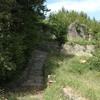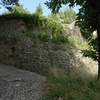Castle of Bergiola
This medieval village has only recently been brought to light due to thick vegetation and neglect caused by a terrible earthquake in Garfagnana in 1920. Still preserved are its high polygonal perimeter walls, some stately homes in ruins and an old mule track leading to the village square, overlooked by the church and the well.
Historical notes
The castled centre of Bergiola is mentioned in very few written records, although some archaeological sources would seem to indicate the existence of the town already in the early Middle Ages. The first documented mention was in 1149, the year in which Pope Eugenius III confirmed the spiritual sovereignty of the Parish of San Lorenzo to the bishop of Luni, with Bergiola among the many villages that had to pay tithes to the church. Tithing was an establishment of ancient origin that meant payment of a tenth of the produce of any economic activity to the ecclesiastical entity as a sign of gratitude to God.
The fortified town was placed on one of the main paths of transhumance and therefore remained viable throughout the Middle Ages. The village was mentioned in 1287 as an independent town, while in 1308 the community was enumerated among those towns that had to carry a candle during the procession of the Holy Cross, an act of devotion that turned into a genuflection of subjection to rulers of the hegemonic cities. A few years later, in 1313, Bergiola was assigned briefly to Spinetta Malaspina. Invested by the fury of the armies of Castruccio Castracani in 1319 this town, like others, went back under the domain of the City of Lucca and from that moment on it was always loyal to the government of Lucca.
Despite the end of the Guinigiano government in 1430 and acquisition by the House of Este of much of Garfagnana, Bergiola remained faithful to Lucca. In 1602, the small castle, whose defences were not brought up to date, was looted and damaged by the armies of the Duke of Este, who penetrated into the territory of Lucca in order to take revenge for the military action that had led to the Republic of Lucca’s occupation of the Este lands of Motrone and Vallico.










